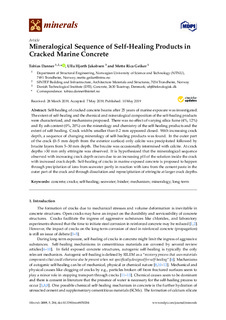| dc.contributor.author | Danner, Tobias | |
| dc.contributor.author | Jakobsen, Ulla Hjorth | |
| dc.contributor.author | Geiker, Mette Rica | |
| dc.date.accessioned | 2019-05-13T10:30:38Z | |
| dc.date.available | 2019-05-13T10:30:38Z | |
| dc.date.created | 2019-05-10T13:16:20Z | |
| dc.date.issued | 2019 | |
| dc.identifier.citation | Minerals. 2019, 9 (5), . | nb_NO |
| dc.identifier.issn | 2075-163X | |
| dc.identifier.uri | http://hdl.handle.net/11250/2597397 | |
| dc.description.abstract | Self-healing of cracked concrete beams after 25 years of marine exposure was investigated. The extent of self-healing and the chemical and mineralogical composition of the self-healing products were characterized, and mechanisms proposed. There was no effect of varying silica fume (4%, 12%) and fly ash content (0%, 20%) on the mineralogy and chemistry of the self-healing products and the extent of self-healing. Crack widths smaller than 0.2 mm appeared closed. With increasing crack depth, a sequence of changing mineralogy of self-healing products was found. In the outer part of the crack (0–5 mm depth from the exterior surface) only calcite was precipitated followed by brucite layers from 5–30 mm depth. The brucite was occasionally intermixed with calcite. At crack depths >30 mm only ettringite was observed. It is hypothesized that the mineralogical sequence observed with increasing crack depth occurs due to an increasing pH of the solution inside the crack with increased crack depth. Self-healing of cracks in marine exposed concrete is proposed to happen through precipitation of ions from seawater partly in reaction with ions from the cement paste in the outer part of the crack and through dissolution and reprecipitation of ettringite at larger crack depths | en |
| dc.language.iso | eng | nb_NO |
| dc.publisher | MDPI | nb_NO |
| dc.rights | This is an open access article distributed under the Creative Commons Attribution License which permits unrestricted use, distribution, and reproduction in any medium, provided the original work is properly cited | * |
| dc.rights.uri | https://creativecommons.org/licenses/by/4.0/ | * |
| dc.subject | Concrete | nb_NO |
| dc.subject | Cracks | nb_NO |
| dc.subject | Self-healing | nb_NO |
| dc.subject | Seawater | nb_NO |
| dc.subject | Binder | nb_NO |
| dc.subject | Mechanism | nb_NO |
| dc.subject | Mineralogy | nb_NO |
| dc.subject | Long-term | nb_NO |
| dc.title | Mineralogical Sequence of Self-Healing Products in Cracked Marine Concrete | nb_NO |
| dc.type | Journal article | nb_NO |
| dc.type | Peer reviewed | nb_NO |
| dc.description.version | publishedVersion | nb_NO |
| dc.subject.nsi | VDP::Teknologi: 500 | nb_NO |
| dc.source.pagenumber | 20 | nb_NO |
| dc.source.volume | 9 | nb_NO |
| dc.source.journal | Minerals | nb_NO |
| dc.source.issue | 5 | nb_NO |
| dc.identifier.doi | 10.3390/min9050284 | |
| dc.identifier.cristin | 1696930 | |
| dc.relation.project | Norges forskningsråd: 245645 | nb_NO |
| cristin.unitcode | 7401,30,40,0 | |
| cristin.unitname | Arkitektur, byggematerialer og konstruksjoner | |
| cristin.ispublished | true | |
| cristin.fulltext | original | |
| cristin.qualitycode | 1 | |

